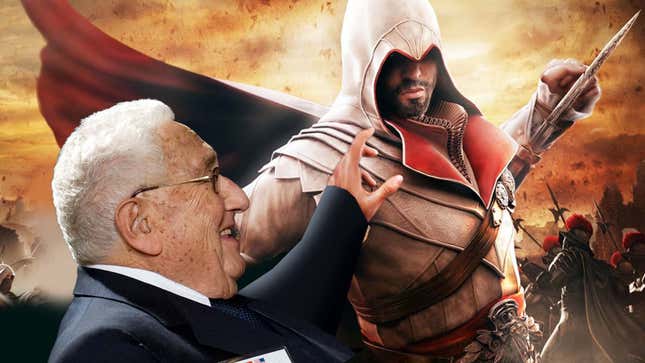
You probably know by now that Henry Kissinger, a notorious war criminal who was the U.S. Secretary of State during Richard Nixon and Gerald Ford’s presidencies, died yesterday, November 30, at the age of 100. You might also know that he was behind the carpet bombings in Cambodia that took place from 1969 to 1973 and the 1973 Chilean coup d’état, both of which resulted in massive casualties and/or destabilization of the regions. What you might not know is that in the Assassin’s Creed series, Kissinger is canonically one of the bad guys of its in-universe lore. You know what they say: Art imitates life.
The Assassin’s Creed series is primarily set within important historical time periods that are interspersed with modern-day segments, and focuses on the secret war between the Assassins and the Templars (yes, like the Knights Templar). Characters use a virtual reality system called the Animus to view and move through their ancestors’ memories, which is how the series weaves together disparate times in history and relates them to the modern day. By 2010’s Assassin’s Creed: Brotherhood, those virtual worlds have started to somewhat unravel, with rifts in history popping up that players can explore.

These rifts are hidden puzzles that contain encrypted information about the antagonistic Templars and their modern-day front, Abstergo Industries. Throughout the Assassin’s Creed series, characters learn that the Templars’ hegemonic efforts for global power have been ongoing for centuries, and major historical events and figures have been part of their order. When protagonist Ezio finds the fifth rift in Brotherhood, he learns that none other than Henry Kissinger was working for the Templars while in power during Nixon and Ford’s presidencies. You can even see a photo of him and Nixon in-game during the rift sequence at the 1:08 mark in this video from Rooster Teeth:
Assassin’s Creed is all about recontextualizing historical moments within its own fiction, so choosing to make a detestable figure in the United States’ history into an extension of its own villainous organization checks out.
For more on Assassin’s Creed, check out Kotaku’s review of Assassin’s Creed: Mirage.

